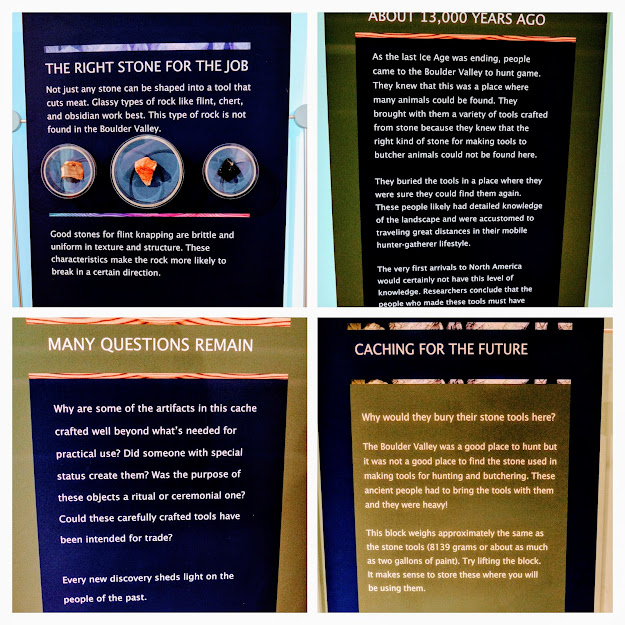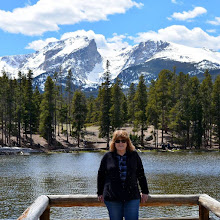A few years ago I blogged about an interesting event my husband and I attended called the International Archaeology Day that was held in Roxborough, Colorado--click here--to read that post. We have always been fascinated by the past, and the people and civilizations that came before modern times and the remnants of their lives left behind. We found the lectures, exhibits, and demonstrations on this special day very enriching. The last lecture of the day was presented by the University of Colorado Boulder Professor Douglas Bamforth about the "Mahaffy Clovis Cache." When landscapers uncovered a collection of 83 stone tools in the front yard of Patrick Mahaffy's home in Boulder, Colorado, the homeowner called the University of Colorado at Boulder's anthropology department and the next day archaeologist Douglas Bamforth came out to investigate. What they discovered is called the Mahaffy Clovis Cache. It contains elaborate stone knives and blades used to butcher ice-age mammals 13,000 years ago!
To be able to examine the tools up close and see their workmanship, and their almost pristine condition was very exciting. They are made of quartzite and chert materials, some of which are not found in Colorado. Professor Bramsforth feels the stones used may have originated in the Uinta Mountains in northeast Utah, the Green River Basin in northwest Colorado and southwest Wyoming, and Middle Park near Kremmling, Colorado. He concluded the Mahaffy Cache likely originated in the Uintas, was carried up the Yampa River Valley in Colorado, then through the Gore Range and into Middle Park. From there they were probably toted to the Colorado River headwaters and over a pass in or near present-day Rocky Mountain National Park, and up and over to the Front Range.
If you'd like to view a short YouTube video about the Mahaffy Cache click here.
You can also find me on
I'm linking this post to the following blog events:
Mosaic Monday, All Seasons, Blue Monday, Through My Lens Monday, Little Cottage Link Party, Hearth, and Soul Link Party, You Are the Star Blog Hop, Inspire Me Monday, Good Random Fun, Nature Notes, Grand Social, Travel Photos, Photo Tunes, Happiness Is Homemade, Over the Moon, Our World Tuesday, Ruby Tuesday, Tuesday Turn About. Tuesdays With A Twist, Let's Keep In Touch, Wordless Wednesday on a Tuesday, Party in Your PJ's, Wordless Wednesday, Nanahood WW, Oh My Heartsie Girl's Wonderful Wednesday, Your Whims Wednesday, Worldless Wednesday My Corner of the World, Wonderful Wednesday, Little Things Thursday, Thankful Thursday, Thursday Encouraging Hearts and Home, Full Plate Thursday, Thursday Thinking Out Loud, Friendship Fridays, Friday Features Linky Party, Skywatch Friday, Pink Saturday, Saturday Critters

































31 comments:
Pat - so hard to imagine something 13,000 years old could be found in Boulder while digging a fish pond! Maybe I should start digging around here! Fascinating. Don't you wonder what future peoples will wonder about the things that we have "thrown out"? What a blessing that you had a museum expert to tell you so much about this discovery. So glad you shared it with everyone at Mosaic Monday!
Hello,
Great post on the tour and the exhibit, it is an fascinating collection of stone tools. Mr Mahaffy was nice to re-bury some of the items back into the spot he found them. Enjoy your day, have a great new week ahead!
You know those tools are really incredible works of art. Just amazing! Thank you! Wishing you a wonderful week!
My husband and I really enjoy museums and history. Thanks for sharing with all the detail you did.
Wonderful post, great photos!
Thanks for linking up at https://image-in-ing.blogspot.com/2020/06/bath-time.html
fascinating subject - I love archaeology and learning about the past
Quite the cache. It really is fascinating to see tools from the past.
It amazes me as to how much they can figure out when they find relics like this. Great photos and I'll watch the video too! Thanks!
fascinating post and subject.
What an interesting way to display the artifacts. It's a good thing the landscaper didn't damage them accidentally and the owners took the initiative to have them removed and preserved. - Margy
How so very interesting and quite educational! This is a fantastic blog post.
By the way I grew up in Colorado...lived north of Boulder in the foothills for over 50 years. My husband was born in Colorado Springs, we have family on the front range & western slope. AND Bud and I followed the Colorado Rockies to Spring Training in Tucson even.
Well that is just pretty cool. Amazing that the cache was disposed of when the were digging the pool.
What a good post and interesting too thanks for the tour
Have a fascinating safetastic week 😷😷😷
It's amazing really, don't you think?
What a wonderful set of finds! Those big stone blades and axes have always fascinated me.
Cheers - Stewart M - Melbourne
This looks like such a fascinating day and so interesting. Archaeology intrigues me. (Have you read the "Ruth Galloway" mysteries by Ellie Griffiths? Very interesting -- set in England!)
How wonderful to see things pulled from an area so close to your own. And it looks like the exhibits were beautifully done.
It is fascinating how much information can be garnered from these ancient tools.
What a ton of info! I bet you could spend several days there and not read it all! Very interesting!
What a delightful thing to do: wander through a museum. I wonder if any museums are open these days?
Absolutely Fascinating...I've been in that area and I can't imagine why someone wouldn't come back for such a huge cace, but then huge cache's of tools are seldom found in that number or in that condition. Again, totally fascinating!Sandi
A very interesting post … thank you.
All the best Jan
Wow, that is a fascinating exhibit. How fortunate to be able to view everything with a learned guide.
Great display.
Imagine finding something like this in your front yard! Incredible. Thank goodness Mr Mahaffy recognized this was an amazing bit of prehistory and knew who to call. And allowed it to be shared. Wonderful to have a special tour. Eons of history in your beautiful state. Thanks for sharing some of it with us.
I love that the professor reburied some tools, along with modern ones for someone to find in the future and wonder how that it is. lol 13,000 years ago isn't so long ago compared to the how old Earth is.
How fascinating.
Dawn aka Spatulas On Parade
What a neat exhibit!! Thanks so much for sharing with us at Encouraging Hearts and Home. Pinned.
A nice and interesting post to read, thank you I
Wow! That is just incredible. It makes one wonder what else is laying around underground that we have not found.
Interesting finds and I would love to participate in work like this. Thanks for linking up and have a great week!
I lOVE this kind of stuff and have been reading and watching a lot of nature and documentaries...
Post a Comment